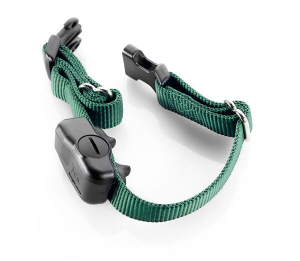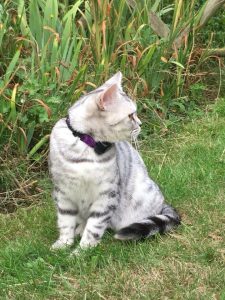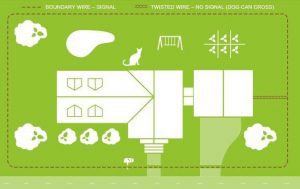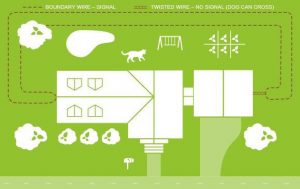How do cat fences work?
Cat fences, how do they work? They are not a physical barrier but an innovative system that offers huge scope to give your cat safety and freedom within your garden. Cat fences actually comprise of a hidden wire which surrounds the perimeter to create the safe area for your cats and a control box and receiver collar.
The boundary wire runs around the property and connects back to an internal control box. Of course, this gives greater flexibility so that all shapes and sizes of property can be “fenced”. What’s even more amazing is that the wire can be buried or installed above ground. The only stipulation with cat fences is that the wire must form the start and finish at the control box or in other words form a continuous circuit.
Whats more uneven and difficult terrains can be “fenced”; the cable can run through wooded areas, up and down slopes and even through streams. All these features allow cats greater freedom and a more natural living environment. To date, the largest cat installation CatFence have installed is 350 acres. That is not to say that cat fences are only for large properties we regularly install in small urban gardens.
So how does this keep my cat at home?
So, the control box sends a coded FM signal via the boundary wire. You cat will wear a small computer collar. The signal is picked up by your cat’s computer collar. When the cat approaches the boundary wire, the collar emits a beep, reminding the cat that they are coming close to the boundary.
If they continue to approach the boundary, the collar delivers a light and harmless impulse through some small probes. This, in turn, prevents the cat from getting any closer to the boundary. With the aid of an indoor training unit, the cat quickly learns how to avoid the “no go zone”. The impulse is both safe and harmless and is the same as the static impulse created by a Tens machine.
In the first few weeks, some temporary marking flags are placed outside to show the “no go zone”. Cats are highly intelligent and they quickly learn to understand the “beep” and will turn back into the safe area. Most cats will not even receive the warning “beep”.
Research and Testing for Cat Fences
Using electronic cat fences for cat containment is relatively new in the UK and so in 2013, a large nationwide study was  carried out. Feline experts at Lincoln University headed up the study and over a 3 period they looked at cats using cat fences, indoor cats and cats allowed to roam were all closely monitored.
carried out. Feline experts at Lincoln University headed up the study and over a 3 period they looked at cats using cat fences, indoor cats and cats allowed to roam were all closely monitored.
In 2016 the study results were released. The experts confirmed that not only are cat fences safe to use that they help save the lives of cats. Interestingly, the study also reported that cats using a cat fence had a closer relationship with their owner! Why because they were not as solitary as those left to wander.
Furthermore, the study reported that Indoor Cats were not only at a higher risk of obesity but sadly also to feline urology disease. Fortunately for those cats using cat fences, these issues were removed. Allowing the cat to roam within the garden still gave the cats the opportunity to display normal feline behavior. Of course, using the cat fences also kept them safe from the dangers outside.
Interestingly people often refer to the impulse as a shock but the experts have confirmed that this term is incorrect and that the pulse generated is an impulse.
Cat Fence Layouts
With our cat fences, you can achieve all sorts of configurations. You can most certainly protect both the front and rear garden. Below are a few examples and images to show just some of the endless possibilities. With a rear garden, only the cable needs to double back on itself to form the loop.

Full Boundary – goes under the drive as well!

Rear garden – cable doubles back on itself to form the loop
The possibilities are endless and our team is happy to draw out and discuss options with you. Click here for a free quote.
